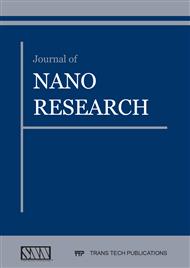[1]
Akbar F, Kolahdouz M, Larimian S, Radfar B, Radamson HH. Graphene synthesis, characterization and its applications in nanophotonics, nanoelectronics, and nanosensing. J. Mater. Sci. Mater. Electron. [Internet]. Springer US; 2015;1–33.
DOI: 10.1007/s10854-015-2725-9
Google Scholar
[2]
Treske U, Ortmann F, Oetzel B, Hannewald K, Bechstedt F. Electronic and transport properties of graphene nanoribbons. Phys. Status Solidi a-Applications Mater. Sci. 2010;207:304–8.
DOI: 10.1002/pssa.200982445
Google Scholar
[3]
Castro E V., Novoselov KS, Morozov S V., Peres NMR, Dos Santos JMBL, Nilsson J, et al. Biased bilayer graphene: Semiconductor with a gap tunable by the electric field effect. Phys. Rev. Lett. 2007;99:216802.
DOI: 10.1103/physrevlett.99.216802
Google Scholar
[4]
Qin C, Wang G, Kolahdouz M, Luo J, Yin H, Yang P, et al. Impact of pattern dependency of SiGe layers grown selectively in source/drain on the performance of 14 nm node FinFETs. Solid. State. Electron. 2016;124.
DOI: 10.1016/j.sse.2016.07.024
Google Scholar
[5]
Wang G, Abedin A, Moeen M, Kolahdouz M, Luo J, Guo Y, et al. Integration of highly-strained SiGe materials in 14 nm and beyond nodes FinFET technology. Solid. State. Electron. 2015;103.
DOI: 10.1016/j.sse.2014.07.008
Google Scholar
[6]
Wang G, Moeen M, Abedin A, Xu Y, Luo J, Guo Y, et al. Impact of pattern dependency of SiGe layers grown selectively in source/drain on the performance of 22 nm node pMOSFETs. Solid. State. Electron. 2015;114.
DOI: 10.1016/j.sse.2015.07.003
Google Scholar
[7]
Guo B, Fang L, Zhang B, Gong JR. Graphene Doping: A Review. Insciences J. | Nanotechnol. Insciences J. 2011;1:80–9.
DOI: 10.5640/insc.010280
Google Scholar
[8]
Mohammadi S, Kolahdouz Z, Darbari S, Mohajerzadeh S, Masoumi N. Graphene formation by unzipping carbon nanotubes using a sequential plasma assisted processing. Carbon N. Y. 2013;52:451–63.
DOI: 10.1016/j.carbon.2012.09.056
Google Scholar
[9]
Mohammadi S, Kolahdouz Z, Mohajerzadeh S. Hydrogenation-assisted unzipping of carbon nanotubes to realize graphene nano-sheets. J. Mater. Chem. C. The Royal Society of Chemistry; 2013;1:1309–16.
DOI: 10.1039/c2tc00408a
Google Scholar
[10]
Hou Z, Yee M. Electronic and transport properties of graphene nanoribbons. 7th IEEE Conf. Nanotechnol. 2007;308:554–7.
Google Scholar
[11]
Giovannetti G, Khomyakov PA, Brocks G, Karpan VM, Van Den Brink J, Kelly PJ. Doping graphene with metal contacts. Phys. Rev. Lett. 2008;101.
DOI: 10.1103/physrevlett.101.026803
Google Scholar
[12]
Gui G, Li J, Zhong J. Band structure engineering of graphene by strain: First-principles calculations. Phys. Rev. B - Condens. Matter Mater. Phys. 2008;78.
DOI: 10.1103/physrevb.78.075435
Google Scholar
[13]
Iyakutti, K., Kumar, E. M., Thapa, R., Rajeswarapalanichamy, R., Surya, V. J., & Kawazoe Y. Effect of multiple defects and substituted impurities on the band structure of graphene: a DFT study. J. Mater. Sci. Mater. Electron. 2016;27:12669–79.
DOI: 10.1007/s10854-016-5401-9
Google Scholar
[14]
Huang B, Yan Q, Zhou G, Wu J, Gu BL, Duan W, et al. Making a field effect transistor on a single graphene nanoribbon by selective doping. Appl. Phys. Lett. 2007;91.
DOI: 10.1063/1.2826547
Google Scholar
[15]
Kolahdouz M, Maresca L, Ostling M, Riley D, Wise R, Radamson HH. New method to calibrate the pattern dependency of selective epitaxy of SiGe layers. Solid. State. Electron. 2009;53.
DOI: 10.1016/j.sse.2009.04.018
Google Scholar
[16]
Radamson HH, Kolahdouz M. Selective epitaxy growth of Si<inf>1−x</inf>Ge<inf>x</inf> layers for MOSFETs and FinFETs. J. Mater. Sci. Mater. Electron. 2015;26.
DOI: 10.1007/s10854-015-3123-z
Google Scholar
[17]
Semiconductor Industry Association. International Technology Roadmap for Semiconductors (ITRS) [Internet]. Semicond. Ind. Assoc. 2013. Available from: http://public.itrs.net.
Google Scholar
[18]
Yu SS, Zheng WT, Jiang Q. Electronic properties of nitrogen-/boron-doped graphene nanoribbons with armchair edges. IEEE Trans. Nanotechnol. 2010;9:78–81.
DOI: 10.1109/tnano.2009.2020797
Google Scholar
[19]
Radamson HH, Kolahdouz M, Shayestehaminzadeh S, Farniya AA, Wissmar S. Carbon-doped single-crystalline SiGe/Si thermistor with high temperature coefficient of resistance and low noise level. Appl. Phys. Lett. 2010;97.
DOI: 10.1063/1.3524211
Google Scholar
[20]
Panchakarla LS, Subrahmanyam KS, Saha SK, Govindaraj A, Krishnamurthy HR, Waghmare U V., et al. Synthesis, structure, and properties of boron- and nitrogen-doped graphene. Adv. Mater. 2009;21:4726–30.
DOI: 10.1002/adma.200901285
Google Scholar
[21]
Fiori G, Iannaccone G. On the Possibility of Tunable-Gap Bilayer Graphene FET. Electron Device Lett. IEEE. 2009;30:261–4.
DOI: 10.1109/led.2008.2010629
Google Scholar
[22]
Khaliji K, Noei M, Tabatabaei SM, Pourfath M, Fathipour M, Abdi Y. Tunable bandgap in bilayer armchair graphene nanoribbons: Concurrent influence of electric field and uniaxial strain. IEEE Trans. Electron Devices. 2013;60:2464–70.
DOI: 10.1109/ted.2013.2266300
Google Scholar
[23]
Martinazzo R, Casolo S, Tantardini GF. Symmetry-induced band-gap opening in graphene superlattices. Phys. Rev. B - Condens. Matter Mater. Phys. 2010;81.
DOI: 10.1103/physrevb.81.245420
Google Scholar
[24]
Kaloni TP, Joshi RP, Adhikari NP, Schwingenschlögl U. Band gap tunning in BN-doped graphene systems with high carrier mobility. Appl. Phys. Lett. 2014;104.
DOI: 10.1063/1.4866383
Google Scholar
[25]
Ci L, Song L, Jin C, Jariwala D, Wu D, Li Y, et al. Atomic layers of hybridized boron nitride and graphene domains. Nat. Mater. Nature Publishing Group; 2010;9:430.
DOI: 10.1038/nmat2711
Google Scholar
[26]
Zheng Y, Jiao Y, Ge L, Jaroniec M, Qiao SZ. Two-step boron and nitrogen doping in graphene for enhanced synergistic catalysis. Angew. Chemie - Int. Ed. 2013;52:3110–6.
DOI: 10.1002/anie.201209548
Google Scholar
[27]
Rabiee Golgir H, Faez R, Pazoki M, Karamitaheri H, Sarvari R. Investigation of quantum conductance in semiconductor single-wall carbon nanotubes: Effect of strain and impurity. J. Appl. Phys. 2011;110.
DOI: 10.1063/1.3641981
Google Scholar
[28]
Nematian H, Moradinasab M, Pourfath M, Fathipour M, Kosina H. Optical properties of armchair graphene nanoribbons embedded in hexagonal boron nitride lattices. J. Appl. Phys. 2012;111:6–11.
DOI: 10.1063/1.4710988
Google Scholar
[29]
Bashirpour M, Kolahdouz M, Neshat M. Enhancement of optical absorption in LT-GaAs by double layer nanoplasmonic array in photoconductive antenna. Vacuum [Internet]. Elsevier Ltd; 2017;In Press. Available from: http://dx.doi.org/10.1016/j.vacuum.2017.07.035.
DOI: 10.1016/j.vacuum.2017.07.035
Google Scholar
[30]
Bashirpour M, Ghorbani S, Kolahdouz M, Neshat M, Masnadi-Shirazi M, Aghababa H. Significant performance improvement of a terahertz photoconductive antenna using a hybrid structure. RSC Adv. Royal Society of Chemistry; 2017;7:53010–7.
DOI: 10.1039/c7ra11398f
Google Scholar
[31]
Kolahdouz Z, Rostamian A, Kolahdouz M, Ma T, van Zeijl H, Zhang K. Output blue light evaluation for phosphor based smart white LED wafer level packages. Opt. Express. 2016;24:174–7.
DOI: 10.1364/oe.24.003216
Google Scholar


